Home » Articles posted by Tessa Sanderson (Page 12)
Author Archives: Tessa Sanderson
JLG’s 670SJ Boom Lift Levels Itself on Slopes Up to 10 Degrees

Wouldn’t it be great if every jobsite was graded smooth, compacted and level before you had to get on it with your boom lift? Yeah, right. Ain’t going to happen.
JLG has come up with the next best thing, the JLG 670SJ self-leveling boom lift, which can automatically level itself on slopes up to 10 degrees in any direction…while driving.
Under the machine, four independent axles, each controlled by smart hydraulic cylinders, enable each wheel to separately follow the contour of the terrain and stay in constant contact with the ground. This allows the machine to continuously self-level, without requiring operator inputs, and navigate uneven terrain while driving at height from one job to another without lowering the boom. It also reduces or eliminates the prep work — grading or building cribbing — required to level the work area so your lifts can get started first thing in the morning. Another time saver: there’s no need for the trial-and-error effort of repositioning to find a level work area.
The 670SJ offers three operating modes:
Self-leveling mode enables the machine to work at max height on slopes up to 10 degrees with full functionality.Travel mode can be used when the boom is stowed to move across the jobsite at faster speed.Shipping mode allows the entire machine to be lowered once it’s in position on a truck, reducing its travel height. >
As to capacity, the JLG 670SJ self-leveling boom lift offers a 73-foot work height and 57 feet of horizontal reach, with 550 pounds of unrestricted and 750 pounds of restricted load. It also features JLG’s automatic, single-sensor, load-sensing system with zero-load calibration. This keeps the machine within the allowable work envelope by limiting range, depending on the platform load.
Did you miss our previous article…
https://constructionosa.org/?p=706
Cat Sales, Revenues Increase 25% in Q3
Caterpillar reported a robust Q3 2021, saying it saw a 25% increase in sales and revenues over the same quarter last year.
Sales and revenues rose from $9.9 billion in 3Q 2020 to $12.4 billion this year, prompted by higher sales volume driven by end-user demand for equipment and services, the impact of changes in dealer inventories and favorable pricing. Dealers decreased inventories by $600 million during Q3 2020 compared with$300 million during the same quarter this year.
Cat also noted its operating profit for the quarter was $1.66 billion, an increase of 69% compared with the same period in 2020. This despite higher manufacturing costs because of higher variable labor, freight and material costs.
Construction Industries
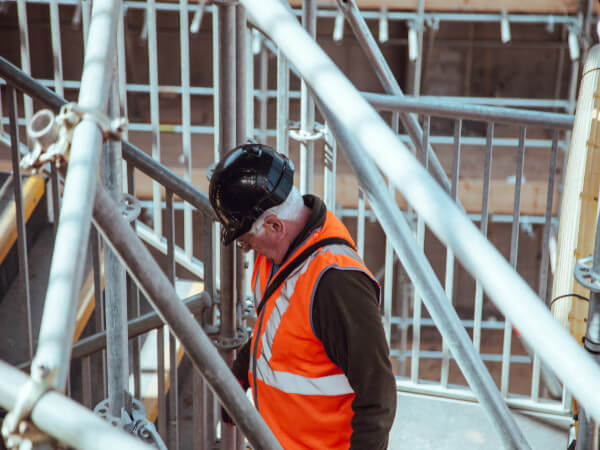
Caterpillar’s Construction Industries Q3 2021 sales by geographic region.Caterpillar
Cat’s global construction industries segment saw a 30% year-over-year increase for the quarter, realizing $5.25 billion in total sales, an increase of $1.99 billion over Q3 2020.
The company’s North American construction markets increased by 36% year over year, driven by higher end-user demand from improving non-residential construction, continued strength in residential construction and dealer inventory changes.
The only geographical construction industries market to see a decrease was Cat’s Asia/Pacific region, due to lower sales volume and dealer inventory decreases, particularly in China.
“Our global team continues to execute our long-term strategy for profitable growth while working to mitigate supply chain challenges as we serve our customers,” says Jim Umpleby, chairman and CEO. “Our third-quarter results reflect higher sales and revenues across our three primary segments and in all regions.”
Did you miss our previous article…
https://constructionosa.org/?p=703
Colorado Contractor Faces $200,000 in Penalties for Trench Death
When rescue personnel arrived at a trench collapse on April 16, they found three workers trying to save a coworker who was stuck in mud and under water.
After a seven-hour operation involving 60 rescue personnel, the body of 50-year-old Luis M. Cortes-Correa was recovered.
His employer, Dunaway Excavating Inc. of Strasburg, Colorado, now faces $203,628 in proposed penalties for four violations, including not providing workers with cave-in protection and protection from accumulating water, according to the U.S. Occupational Safety and Health Administration.
The workers were connecting a sewer pipe between the main line and a home under construction in Johnstown, Colorado. The area has a high water table because of the nearby Big Thompson River. They were using a pump of some type at the bottom of the trench, so they could see the sewer main, according to the Loveland Fire Rescue Authority.
The trench was 16 feet deep, and 19 feet wide at the top. It narrowed to 11 feet at the bottom and had 2 feet of water in it, OSHA reported.
As water continued to flow into the bottom of the trench, the walls partially collapsed from the bottom. Water rushed in and covered a worker who also became trapped in the collapsed mud, the rescue authority said.
After they arrived, rescuers ordered the three construction workers out of the trench for fear of further collapse. The operation soon turned from rescue to recovery “due to the continued collapse threat and constant groundwater flow,” the rescue agency said.
Rescue workers were unable to stabilize the walls of the funnel-shaped trench as water continued to flow in. While vacuum trucks and pumps removed the water, construction equipment on site was used to try to recover the body. The operation also involved removing a natural-gas and power lines.
After the Loveland Fire Rescue Authority’s recovery operation, Battalion Chief Tim Smith urged contractors to use trench boxes and other protection for workers in trenches.
“It’s more time and effort,” Smith said, “but what they don’t see is the outcome if they don’t use these safety devices.”

Rescue personnel worked seven hours into the night April 16 in recovering the body of a worker who died in a trench collapse in Johnstown, Colorado.Ian Zahn, Loveland Fire Rescue Authority volunteer photographerThe coroner ruled that Cortes-Correa’s cause of death was mechanical asphyxia/drowning.
After an investigation, OSHA determined the trench had not been properly sloped, benched nor had any protective system in place, such as a trench box. It said the employer had not provided training to workers on recognizing cave-in and accumulated-water hazards.
OSHA also determined Dunaway had not provided a means for employees to safely get out of the trench. The two ladders did not extend at least 3 feet beyond the top of the trench, and one of the ladders was damaged.
Along with the $203,628 in proposed penalties, Dunaway was placed in OSHA’s Severe Violator Enforcement Program, “which concentrates resources on inspecting employers who have demonstrated indifference to their OSH Act obligations by committing willful, repeated, or failure-to-abate violations.”
“The threat of trench collapses makes excavation work among the most dangerous jobs in the construction industry,” says OSHA Area Director Amanda Kupper in Denver. “This worker’s life and family’s grief could have been spared if required precautions had been taken.”
Did you miss our previous article…
https://constructionosa.org/?p=700
Road Projects Feel the Pain of Congress’ Last-Minute Funding Extensions
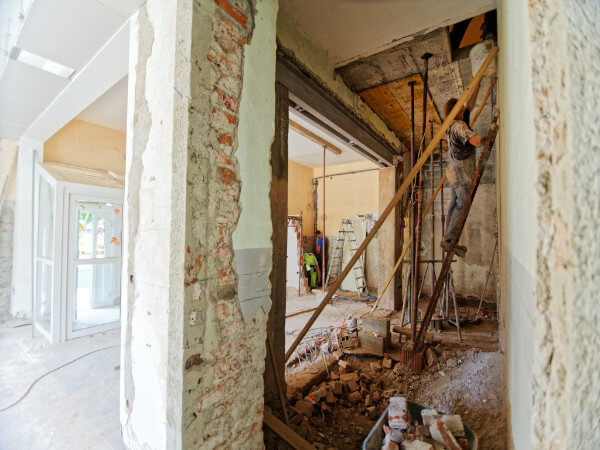
Construction, engineering and transportation groups are frustrated by the House once again delaying a vote on the $1.2 trillion infrastructure bill and also having to enact another short-term extension of federal transportation funding.
“Repeated month-long extensions of the federal funding programs for transit, roads and bridges mean that cities and states cannot move forward with critical transportation projects,” says Tim Smith, executive director of the American Society of Civil Engineers.
On Thursday, a House vote on the Infrastructure Investment and Jobs Act was delayed after negotiations among Democrats broke down. The House did, however, extend transportation funding until December 3. The funding was set to expire October 31 after a previous 30-day extension.
Meanwhile, construction and related industry associations are becoming more frustrated, not only at the inability to pass the infrastructure bill but at leaving states in a lurch with last-minute, temporary extensions.
A recent survey of departments of transportation around the country revealed that many DOTs face uncertainty with planned road and bridge contruction projects because of the temporary extensions.
In the survey, conducted by the American Association of State Highway and Transportation Officials, the Kentucky Transportation Cabinet commented:
“Over the next four months, KYTC has over a quarter of a billion dollars in projects scheduled for construction lettings. Without the certainty of full federal-aid highway funding, many of these projects could be delayed until federal funds are in hand.”
The Alabama Department of Transportation reported that a lack of long-term funding would ripple through the state’s economy:
“The impacts of a short-term extension are not just project-related; it also increases labor, construction and material costs affecting ALDOT and its contractors, consultants, material suppliers and Alabama citizens who work for these businesses. Many of these businesses and employees are still struggling to recover from Covid-19-related effects, and the postponing of work a short-term extension generates is profound and unfortunate.”
Transportation funding almost expired
The Senate passed the Infrastructure Investment and Jobs Act in a bipartisan vote August 10.
But since it moved to the House, progressive Democrats have been using the bill as leverage to try to pass the Build Back Better Act. That bill started with a $3.5 trillion price tag that includes such things as pre-kindergarten, expanded health care coverage and environmental initiatives.
At the same time, almost every Republican in the House plans to vote against the infrastructure bill, despite 19 Republicans supporting it in the Senate. They call the infrastructure bill a “Trojan horse” to try to ram through the BBB Act.
As the political bickering and negotiations continue, state departments of transportation – and those who build roads and bridges – around the country were three days away from seeing federal transportation funding expire and 3,700 USDOT employees furloughed. That’s because a last-minute extension enacted earlier this month was set to end October 31.
“Legislators cannot continue granting extensions from month to month using funding estimates from the previous decade without causing uncertainty for workers and business owners in the communities they are elected to serve,” says National Asphalt Pavement Association President and CEO Audrey Copeland.
What’s next?
President Joe Biden and Democrats in the House and Senate continue to hammer out the details of the Build Back Better Act.
Biden scaled back the proposal Thursday from $3.5 trillion to $1.75 trillion in the hopes of satisfying moderate Democrats while also keeping some of his priorities and getting the infrastructure bill to his desk.
Progressive Democrats still want the House to vote on the BBB Act and the infrastructure bill together. They also say they need to see the text of the reduced BBB Act before voting on it.
Congress now faces a December 3 deadline for federal transportation funding. That’s also when the federal debt ceiling needs to have been extended, or the government could default on its debt.
Congress is expected to return to session Monday.
The Associated General Contractors of America’s CEO, Stephen E. Sandherr, called on progressive Democrats and Republican leadership to consider the infrastructure bill outside the lens of partisan politics and think of its impact on an economy still emerging from the pandemic-induced slowdown.
“It is extremely disappointing that some progressive Democrats and the Republican leadership would again delay passage of a much-needed infrastructure bill,” Sandherr said. “This legislation will provide investments that will make our fragile supply chains more efficient while providing a needed boost to economic growth and employment levels.”
Did you miss our previous article…
https://constructionosa.org/?p=697
Improve Excavation Efficiency 45% with Volvo/Topcon Precise Excavator Control

In the first stages of GPS-driven machine control, this technology enabled many contractors to park their motor graders and finish grade with a dozer. As GPS machine control migrated to excavators some even found it possible to finish grade complex contours with their digging machines.
Now Topcon and Volvo have taken steps to further enhance the precision and versatility of excavator machine control by combining Volvo Active Control on the Dig Assist with Topcon’s 3D-MC software on applicable Volvo excavators. And it’s all factory-installed and supported by Volvo dealers.
With the integration, Volvo Active Control automates the digging process and Topcon’s software syncs with the Volvo menus, allowing operators to customize how they want their automatic controls to function. The combined technologies make it easy to dig straight, perfectly on-grade trenches or carve complex elevations, shapes and contours automatically. The GPS-guided bucket stops when it reaches the designed grade, so you move the dirt only once and you never over dig and thus never have to recompact or regrade using an additional machine. According to Volvo, these features can improve excavation efficiency by as much as 45%.
Recent updates to Topcon’s 3D-MC software include over-the-air access to Sitelink3D, support for LandXML files, over-the-air remote support and a new graphical user interface. In addition to being 3D machine control capable, Volvo’s Active Control software supports auto-tilt features for tilt buckets and Steelwrist tiltrotators. It also offers several position limiting features for the bucket and boom such as return-to-dig (bucket recall) and automatic back grading. Volvo’s Boundary Limits package enables operators to automatically stop the swing motion at a set angle to assist in digging and truck loading. It also provides pre-set boom and bucket elevations and swing to avoid side or overhead obstacles.
For customers in North America, the integrated technology is offered on three models, the EC220E, EC250E and EC300E, with additional models to be added to the list in 2022. For customers in Europe, Oceania and Asia, Volvo Active Control is currently available on the Volvo EC220E, EC250E, EC300E and EC350E crawler excavators.
Did you miss our previous article…
https://constructionosa.org/?p=694
Hitachi Renames U.S. Subsidiary Following Deere Split

The U.S.-based subsidiary in charge of the manufacturing and sales of Hitachi brand wheel loaders in North America will now be known as Hitachi Construction Machinery Americas Inc.
Effective October 1, the name change comes on the heels of Hitachi and Deere announcing the dissolution of their joint venture for manufacturing excavators in North and South America.
Hitachi says the new name corresponds with its plans to establish an independent network of construction equipment sales and parts and services business operations in North, Central and South America. Starting in March, Hitachi will independently deploy new products, technologies and services in the regions.
The previous name, Hitachi Construction Machinery Loaders America, was established in 2017 after the company purchased KCM wheel loaders. HCMA will operate as a wholly-owned subsidiary of Hitachi Construction Machinery based in Japan.
Hitachi saw a significant bump in revenue following the dissolution of the Deere joint venture. The company posted a 31.3-percent increase in revenues for its second quarter (ending September 30, 2021), compared to the same period last year. In issuing its results, Hitachi said sales prices for the Americas were adjusted following the split, bringing the company’s adjusted operating income to 38,102 million yen (an increase of 248.3-percent year-on-year).
According to a company press release, Hitachi Construction Machinery will conduct a thorough review of the organizational structure of the Newnan, Georgia-based regional headquarters as it seeks to strengthen the position of the company and its promotion structures in the Americas.
The company plans to add staff to better respond to sales, service and regional market needs for all Hitachi Construction Machinery products, including wheel loaders, compact and construction-sized hydraulic excavators, ultra-large mining excavators, and mining dump trucks.
In Japan, Sonosuke Ishii, senior vice president and executive officer, president of the mining group, has also served as general manager of the America Business Division since October 1.
In the U.S., with the establishment of HCMA, Ishii has also been appointed chairman of the company. Masaaki Hirose, former chairman, has served as vice chairman, working together with Alan Quinn, managing director, to strengthen cooperation between Japan and the Americas.
The company also established Americas Business Expansion Support Office to support the regions through the Hitachi Construction Machinery Group.
Did you miss our previous article…
https://constructionosa.org/?p=691
Elon Musk’s 29-Mile Vegas Loop Under the Strip Wins Approval (Video)
Elon Musk’s Boring Company has won permit approval and a franchise agreement to build the Vegas Loop under the Las Vegas Strip.
The 29-mile underground transportation system would connect with the Las Vegas Convention Center Loop that opened in June. That .8-mile link transports convention center goers through tunnels in electric Teslas and is Musk’s first fully commercial operational tunnel.
The Vegas Loop would have 51 stations throughout the Strip and into Clark County and would have a capacity of 57,000 passengers per hour. The Clark County Commission approved a special-use permit October 20 for The Boring Company to apply for and receive building permits to build the tunnels, according to the Las Vegas Convention and Visitors Authority.
The commission also approved a franchise agreement with Boring that allows it to operate the Loop. Boring would pay to build the Loop and then collect fares from passengers. The commissions says no tax dollars would go toward funding the project. The franchise agreement also faces a vote by the Las Vegas City Council.
Along with the Strip, the Vegas Loop would connect to downtown, McCarran International Airport and Allegiant Stadium. The Boring Company says the goal is to eventually link Las Vegas and Los Angeles.

A map of the proposed route of the Vegas Loop to be built by Elon Musk’s Boring Company.The Boring CompanyBoring and Las Vegas convention center representatives hailed the Vegas Loop as a relief to the city’s traffic congestion and an easier way to get visitors to their destinations. An example provided by Boring says a trip from the convention center to Mandalay Bay, which can take up to 30 minutes, would be shaved to 3 minutes with the Loop.
“The Vegas Loop will be a game-changer for our visitors in moving them around our exciting destination quickly, conveniently and in an entertaining ‘Only Vegas’ way,” says Steve Hill, LVCVA president and CEO.
The electric Teslas would travel through the tunnel directly to a passenger’s destination station with no stops along the way, unlike a subway system. The Boring Company provided the following sample trips and fares:

Sample fares for the future Vegas Loop, which would be self-supporting.The Boring Company
Musk envisions the Teslas reaching speeds of up to 150 mph and being autonomously driven. High-occupancy automated electric Teslas are also planned that would hold up to 16 passengers with sitting and standing room.
The convention center Loop, which opened in June, consists of a mix of 62 Tesla Models 3 and X that have drivers and reach top speed of 40 mph, because of the tunnels’ short length. They can hold up to five passengers.
The convention center tunnels are 40 feet underground. Riders can travel across the convention center campus in 2 minutes versus a 25-minute walk. The Loop debuted at World of Concrete this year. It cost $52.5 million to build. It has a capacity of 4,400 passengers per hour and three stations.
Check out this video of the convention center Loop:
CMSBrowserComponents.load({ el: ‘#vue-1635441286480-229’, name: ‘OEmbed’, props: {“mountPoint”:”/__oembed”,”url”:”https://youtu.be/UIP0WQnQyps”,”attrs”:{“type”:”oembed”,”id”:”https://youtu.be/UIP0WQnQyps”,”element”:”aside”}}, hydrate: false });
Did you miss our previous article…
https://constructionosa.org/?p=687
Dig in Tight Spots with Komatsu’s New PC78US-11 Compact Excavator
Komatsu has introduced a new “tight tail swing” excavator well-suited for urban environments, confined spaces and crowded jobsites.
With its 68-horsepower engine, six work modes and swing radius under 5 feet, the PC78US-11 can handle precise digging, as well as large excavation tasks.
The 12-foot 2-inch boom has a greater raising angle and a short implement swing radius (6 feet 9 inches minimum), giving the PC78US-11 the ability to dig efficiently in a crowded space. At the rear, the tail swing radius measures just 4 feet 7 inches. Viewed from above, both the front and the rear corners of the superstructure are rounded, with the maximum cab extension over the tracks at just 9 inches.
For fast digging

Komatsu’s newest tight tail swing excavator is ideal for urban environments and confined spaces.Komatsu
Good operators like a quick machine, and Komastu’s faster boom up and swing speed increases productivity by 9%. To better match machine performance to the application, Komatsu arms the PC78US-11 with six work modes: power, economy, lifting, breaker, attachment-power, and attachment-economy.
For operators who prefer backhoe-style controls, a pattern change selector valve comes standard. The grading blade has a new moldboard profile to improve backfilling and grading efficiency. The PC78US-11 accepts buckets from 0.10 to 0.26 cubic yards.
Low maintenance demands
A new high-output 2.4-liter, Tier 4 Final engine gives you ground-level access to service points. The heavy-duty, high-pressure common rail fuel injection system and cooled exhaust gas recirculation (CEGR) achieve near complete combustion in cylinder to reduce emissions.
A Komatsu diesel oxidation catalyst removes exhaust soot and enables 100% passive regeneration without a diesel particulate filter or regular refills of diesel exhaust fluid. The no-DPF, no-DEF design translates into lower owning and operating costs, reduced maintenance and one less component to replace or worry about.
Komatsu’s compact engine makes room for a fan clutch system, allowing engine and hydraulic system tuning to reduce noise by a full decibel. Typical in-cab noise levels measure 71 decibels — about the same as a household vacuum cleaner. When engine cooling is not required, the viscous fan clutch reduces parasitic horsepower draw. Overall engine improvements boost fuel efficiency as much as 13%.
Cab comfort
The air-suspension seat has deep side supports and an adjustable backrest angle to support operators of all sizes. The cab comes with AM/FM radio with USB and Bluetooth technology.
Komatsu improved cab dampening by incorporating a spring and a longer stroke on the viscous cab mounts. This, plus a beefed up deck, reduces vibration to the operator to keep him or her more comfortable and focused throughout the day. The sealed and pressurized cab keeps dust out and automatically maintains temperatures to the level set on the monitor.
A sliding cab door makes access easier, especially when you’re entering or exiting the excavator up against a wall or in confined spaces. The cab is ROPS certified and satisfies the requirements of ISO OPG Top Guard Level 1 for falling objects.
Crowded jobsites often restrict sight lines, so Komatsu added a 7-inch LCD display to the PC78US-11 with a standard rearview camera image. LED lights provide nighttime illumination of the jobsite.
The variable displacement/axial piston hydraulics for the boom, arm, bucket, swing and travel circuits offer a maximum flow of 44.4 gallons per minute. Relief-valve settings for implement circuits are rated at 4,264 psi. The auxiliary circuits put out 36.5 gpm/3,830 psi (two way) and 21.1 gpm/2,490 psi (one way).
For travel and trailer considerations, the PC78US-11 has an operating weight of 17,747 pounds.
Did you miss our previous article…
https://constructionosa.org/?p=684
Spot the Robot Dog Fetches Your Data and Brings Back As-Builts

You might just see this unusual looking dog roaming around construction sites soon. But don’t call the pound just yet. The robotic dog known as Spot is armed with Trimble’s X7 3D laser scanner and Trimble FieldLink software to collect data while navigating challenging, dynamic and potentially unsafe environments.
The full integration of Trimble’s scanner and software with Spot (built by Boston Dynamics) means users don’t have to figure out how to sync all the technology. It comes as a turnkey unit ready to go.
“Using the X7 integrated with Spot lets us document changes on the jobsite and make important decisions in the field, rather than waiting hours or potentially days for the information to be relayed to our project staff,” says Thai Nguyen, director of virtual design and construction at Hensel Phelps. “This allows us to make the best decisions as quickly as possible with the best information.”
The integrated unit allows you to create a predefined path of waypoints for Spot to follow as it collects laser scans like a well-trained pup. The data-collection runs can be scheduled on a regular basis with Spot autonomously covering exactly the same ground for design validation and progress reporting, creating real-time, as-built data analysis in the office and field.
Laser scans can be matched to a jobsite project coordinate system as well as individual scan stations. Once the data are collected, they’re turned into a composite point cloud in real-time on the Trimble tablet controller before leaving the site. Spot’s docking station enables in-field battery charging on both the robot and the X7 3D laser scanner and provides the continuous transfer of data through a Gigabit Ethernet connection to the office.
The complete solution includes the Trimble X7 3D laser scanner, Trimble FieldLink software, a ruggedized tablet controller, and Boston Dynamics’ Spot Enterprise robot with enhanced autonomy features, plus an integrated self-charging docking station for Spot and the laser scanner. The package is available through Trimble and select BuildingPoint distribution partners.
What makes Spot unique among robots is his ability to “see” and walk over obstacles, climb stairs, dodge people and equipment and navigate rough terrain. That can be your usual jumbled up jobsite, but you can also send Spot and its Trimble scanner off to collect data in confined spaces or places that are hazardous for people.
If Spot looks familiar it’s because we’ve reported on his progress before, including the time when the clever canine was spotted roaming around the Trimble booth at ConExpo 2020. Check out some of our previous coverage in the links below:
Spot the robot ‘dog’ could one day scan jobsites, do layouts and maintain machines if Trimble, Hilti, Boston Dynamics collaboration succeedsHow Spot the Robot Dog Got a Job in Construction | The Dirt #17
Did you miss our previous article…
https://constructionosa.org/?p=681
Almost Famous: This “Like New” 1956 Cat D6 Dozer Gets a Shot at the Movies
Erik Christenbury often gets calls from people wanting to display antique Caterpillar construction equipment. But one that stands out in his mind came about seven years ago from a coordinator on a major motion picture.
The coordinator was calling from Wilmington, North Carolina, on behalf of the director, and he needed a 1950s era dozer.
As founder and president of Chapter 12 of the Antique Caterpillar Machinery Owners Club, Christenbury was happy to assist. Assuming the movie was being shot in his home state, he sent a photo of his 1956 Cat D6 9U dozer. He had bought the machine about a year earlier – a rare find as it had less than 900 operating hours on it and all original parts.
It was about as brand new as a 1956 dozer could be. He said the director was welcome to use it.
He soon learned the movie was being shot in New Orleans – more than 800 miles away from his home in Liberty, North Carolina. Christenbury looked around for antique dozers closer to the movie location, but the director had his heart set on his D6. He wanted it in New Orleans by 5 a.m. on a Monday.
Along with the long distance, the dozer’s blade made it a wide load, so it couldn’t be hauled on a Sunday when wide loads are prohibited, unless the blade was removed. Christenbury let the coordinator know it wasn’t going to be cheap. He immediately got the OK after sending in his quote.
He and his friend removed the blade, loaded up the dozer and hit the road to New Orleans.
“We pulled up on the movie set about 9 o’clock Sunday night, and they had a security guard there,” Christenbury recalls.
It was just a little house by the side of the road. It didn’t look like a movie set.
“I was like, ‘Is this the right location for the movie?’”
The guard said it was.
“Where can we unload?”
Grandfather’s 1940 D2
Christenbury began his antique Caterpillar equipment collection in the 1990s, starting with the D2 tractor his grandfather bought new in 1940. A dealer had talked his grandfather into trading in his gasoline-powered Cat Fifteen for the new diesel-powered tractor, which was quickly becoming popular with farmers. He paid $1,800 for it.
His grandfather used the D2 as a drawbar tractor on his cotton farm for terracing, plowing, and dragging logs out of the woods.
“He always said that was his favorite tractor,” Christenbury recalls.
Christenbury bought the worn old tractor from his grandfather. He cleaned it, got it running and slowly restored it over a period of years. He calls it the pride and joy of his collection, and it was just the beginning.
“That was what started our Caterpillar collecting,” he says. “And unfortunately, Caterpillar made a lot of different models. So as a collector, you decide, ‘Hey, I’d like to have one of each model.’ And then it just grows from there.”

Erik Christenbury, right, restored this Caterpillar D2 dozer that Erik’s grandfather bought new for $1,800 in 1940. Christenbury owns ChrisCo Machinery in Liberty, North Carolina, where he buys, sells, rebuilds and manufactures industrial woodworking machinery.Erik Christenbury
Finding a “like new” 1956 D6
Today Christenbury has about 150 pieces of antique Cat equipment he has acquired from all over the country. One of those is the 1956 D6 9U he lucked upon one day.
While driving down a highway, he saw it covered with a blue tarp in a front yard.
“I turned around and knocked on the front door,” he recalls. “An older man came to the door and gladly talked about his tractor.”
Charles Moretz had operated the D6 since his employer bought it in 1956. When his boss no longer needed it on the farm and decided to sell it, Moretz bought it and had kept it all those years. It had less than 900 hours on it, and all parts were original. Christenbury let him know that if he ever decided to sell, he’d be interested.
“Halfway home my phone rang,” he says. “It was the owner of the D6 I just looked at, offering it to me for purchase.
“Needless to say, we struck a deal on the phone, and I picked it up the very next day.”

Charles Moretz was the original operator of the 1956 Cat D6 dozer. Erik Christenbury purchased the dozer from him. It had less than 900 hours and all original parts.Erik Christenbury
He needs a hat
Christenbury and his friend were soon met by the director after they arrived at the movie’s staging area at 5 a.m.
Christenbury didn’t know the name of the movie, what it was about or how they intended to use the D6. He was surprised when the director asked him if he could operate it for them. He said he’d be glad to teach someone, that it wouldn’t take long to learn.
“We’d rather have you do it,” the director said.
Christenbury agreed and soon his hair was getting cut, his goatee shaved, makeup applied and his 1950s-style wardrobe donned. But there was one thing missing.
“Every good dozer operator wore a hat to keep the sun out of his eyes,” Christenbury told them. “You’ve got to give me a hat.”
So they did.
“They gave me this hat that looked like Indiana Jones.”
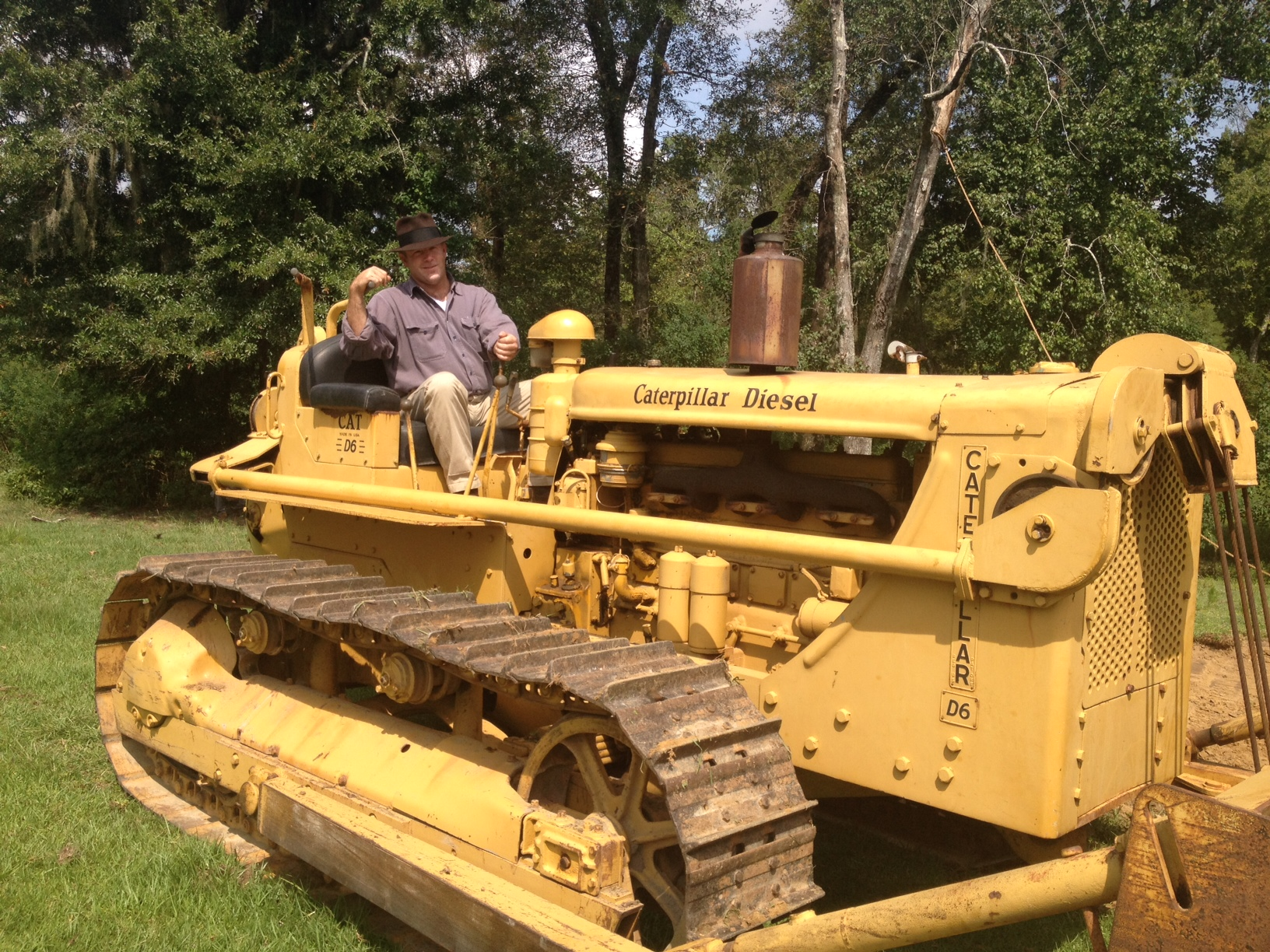
Erik Christenbury with his 1956 Cat D6 on the movie set, dressed in 1950s wardrobe – and Indiana Jones-style hat.Erik Christenbury
Dozer operator/movie actor
After a long wait, Christenbury was told where to put the dozer and where the cameras would go. He still didn’t know the movie’s name or story line.
“I was like, ‘Well, what are we going to do with it? Are we burying dead people? Are we building something? Making a road?’”
The director said, “We’re making a pond.”
“I can make you a pond,” Christenbury replied.
And so for about 5 minutes, he moved dirt while they filmed. Later, they had him lean up against a pickup truck and pretend to talk to one of the characters while the main actors were behind him.
He was about to leave early the next morning when the coordinator who had hired him said they needed him for one more day. The director wanted another shot with the dozer.
“So I’m pushing dirt again, and they’re throwing dust in the air,” he says. “And they’re zooming up on the tracks as it’s moving and dirt spilling over the blade and that kind of stuff.”
The script described it: “A ROARING BULLDOZER’s iron snout dredges up earth.”
It lasted about 5 or 10 minutes, and the scene was done. Christenbury and his friend could head back home to North Carolina.
“Children of the Corn” reunion
While on the set, Christenbury eventually learned that the name of the movie was “Trumbo,” starring Bryan Cranston, Diane Lane and John Goodman.
“We saw Diane Lane and Bryan Cranston,” Christenbury says. “John Goodman wasn’t there yet, but I saw a lot of actors.”
The movie is based on the life of Dalton Trumbo, a screenwriter who was blacklisted during the McCarthy era. Christenbury’s scene was to show that Trumbo had come into some money and wanted to build a lake by his home.
Christenbury, of course, was the dozer operator. His friend was the surveyor.
Playing the general contractor in the scene was Sean Bridgers, an actor Christenbury had met before.
At age 16, Christenbury had played a role in the horror flick “Children of the Corn Part II – The Final Sacrifice,” which was shot near his home in North Carolina.
Bridgers was also in the movie, which came out in 1992.
Christenbury, who was big for his age, was a stunt assistant and also played one of the children of the corn. “I was one of the terrors that went around killing people,” he says. One of his “victims” was a doctor he “stabbed.”
So when he saw Bridgers on the “Trumbo” set, he ran after him.
“Hey, buddy, were you in ‘Children of the Corn Part II?’” he asked.
Bridgers said he was, turned back around and kept walking.
Later, Christenbury got a second chance to get reacquainted. He was on the set later in the day when Bridgers walked around the corner.
“You don’t remember me,” Christenbury said, “but I was in the ‘Corn’ movie with you way back when.”
Bridgers started to remember.
“We talked and he was real nice guy,” Christenbury says.
“It’s funny,” Christenbury recalls telling Bridgers. “The only two movies I’ve ever been in in my whole life, you were in both of them.”
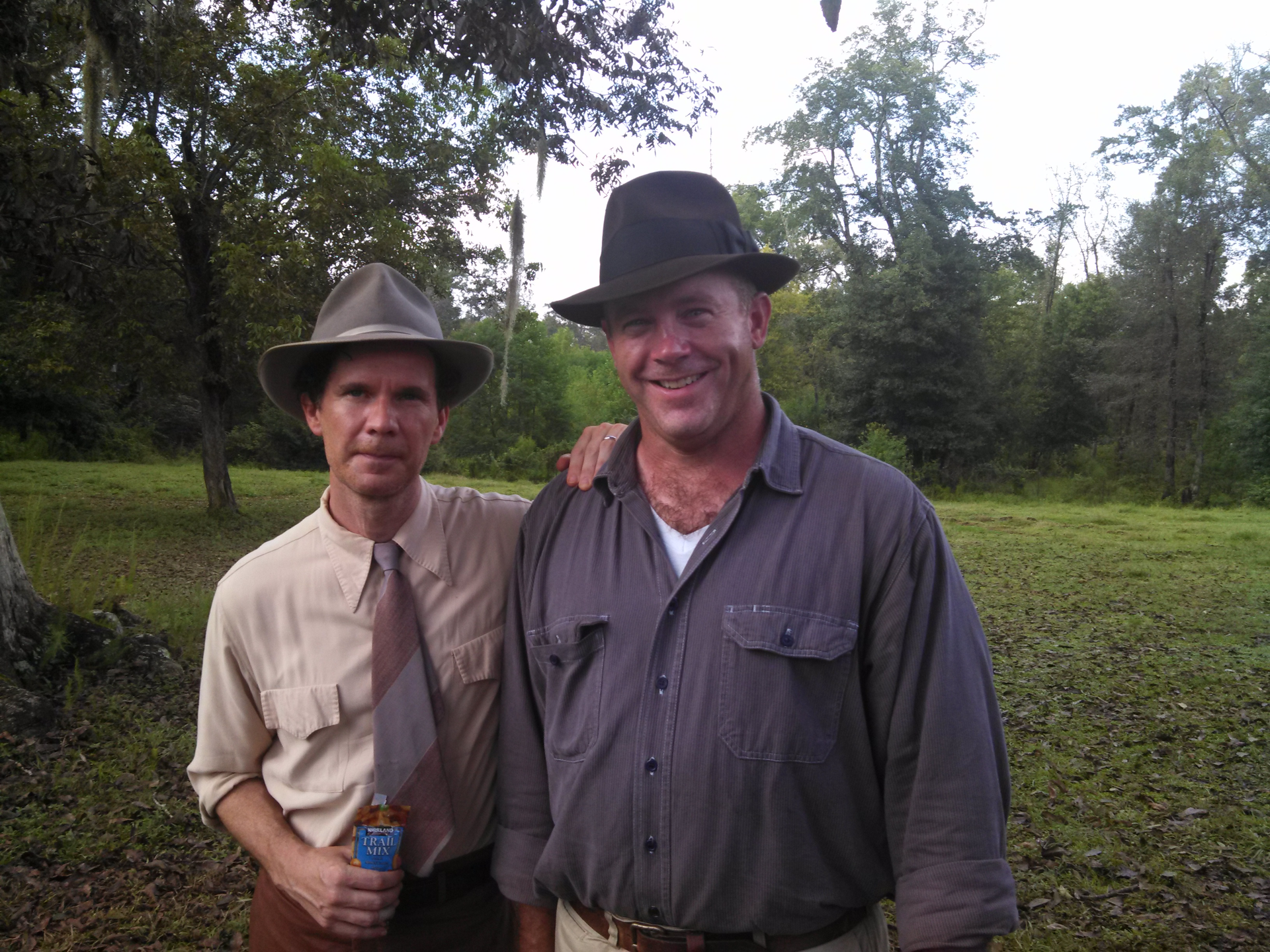
Actor Sean Bridgers poses with Erik Christenbury on the “Trumbo” movie set. Bridgers played the general contractor for the pond’s construction, while Christenbury operated his 1956 Cat D6 dozer.Erik Christenbury
Watching “Trumbo”
When “Trumbo” came out in 2015 several months after Christenbury had hauled the D6 to New Orleans, he took his father and his friend to see the movie at the local theater.
In the opening scene, Trumbo is looking out over a lake.
In the theater, Christenbury punched his buddy in the arm.
“We didn’t make the cutting room floor,” he tells his friend. “They cut us out.”
“What do you mean?” his friend says.
“There’s that lake we were supposed to have built.”
Christenbury laughs while recounting the moment.
“So sure enough, they cut that out of the movie,” he says.
Despite all the work and being cut from the film, Christenbury enjoyed the experience. It was fun seeing the movie stars. It also helped that he was paid well.
He adds that he was in good company, noting that Bridgers met the same fate.
“His part got cut out of the movie, too,” Christenbury says. “So I didn’t feel too bad.”
As for the D6, it’s fame for now is relegated to antique equipment events.
“We proudly take it to shows and demonstrate the machine, giving lots of new operators a chance at the controls,” he says.
“It’s not everyday you get to operate a ‘like new’ 1956 machine.”
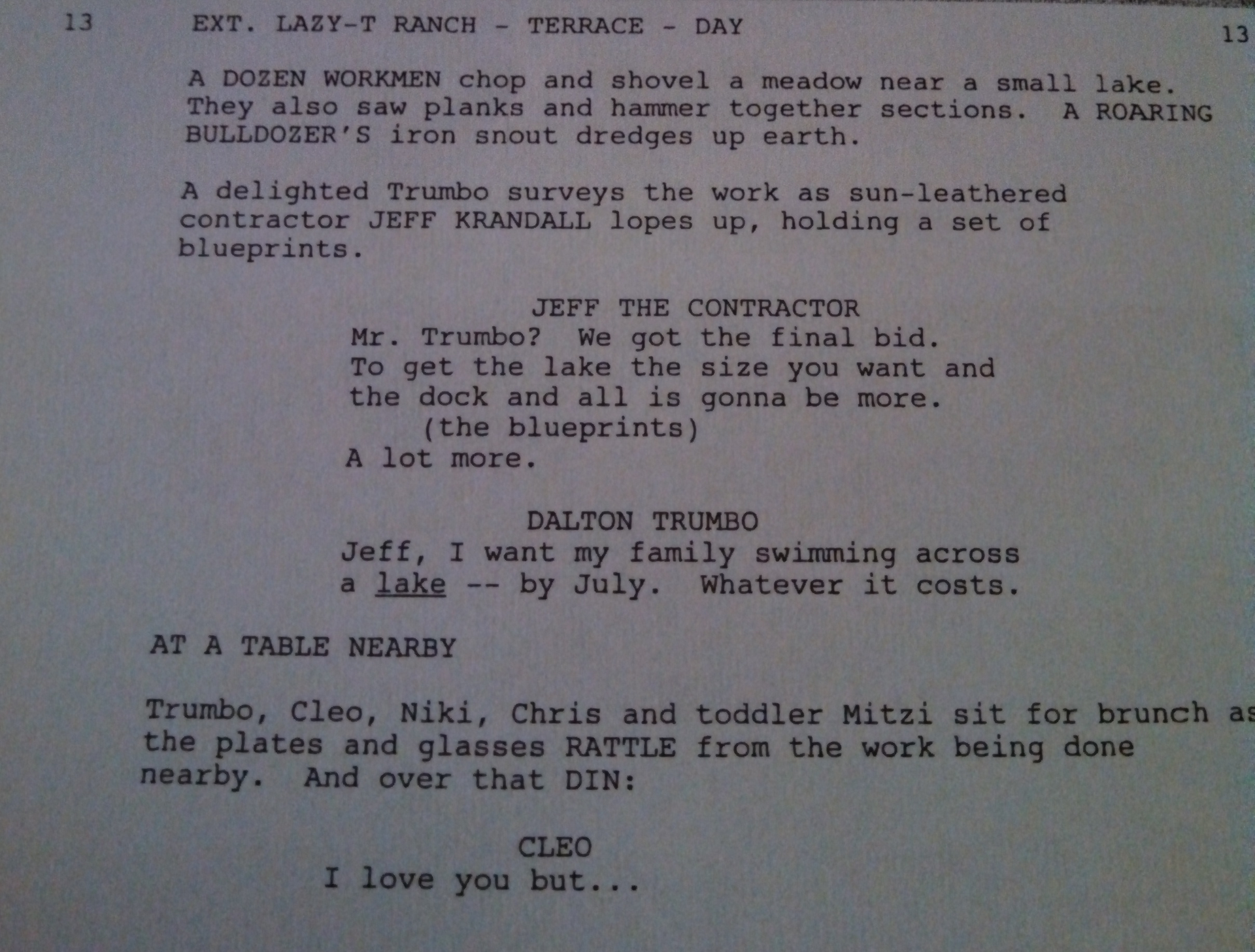
A glimpse of the movie script for “Trumbo” for the lake-building scene that Erik Christenbury operated his 1956 Cat D6 in.Erik Christenbury
Did you miss our previous article…
https://constructionosa.org/?p=674